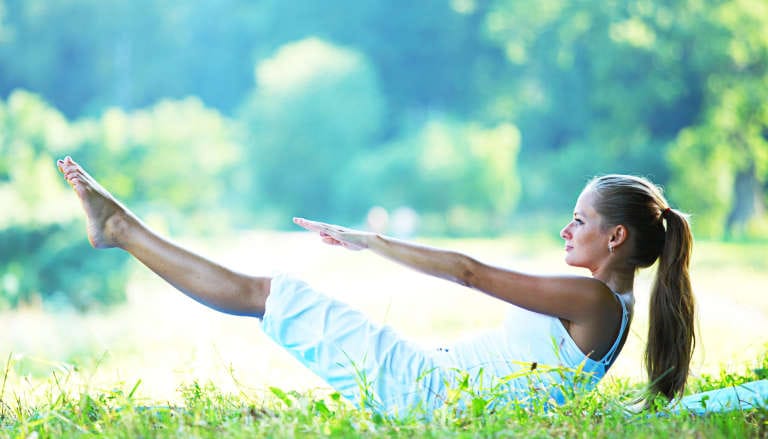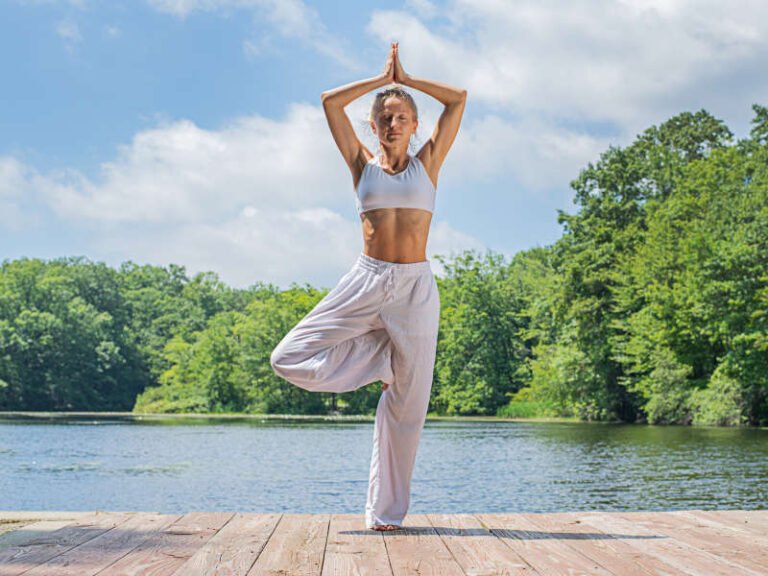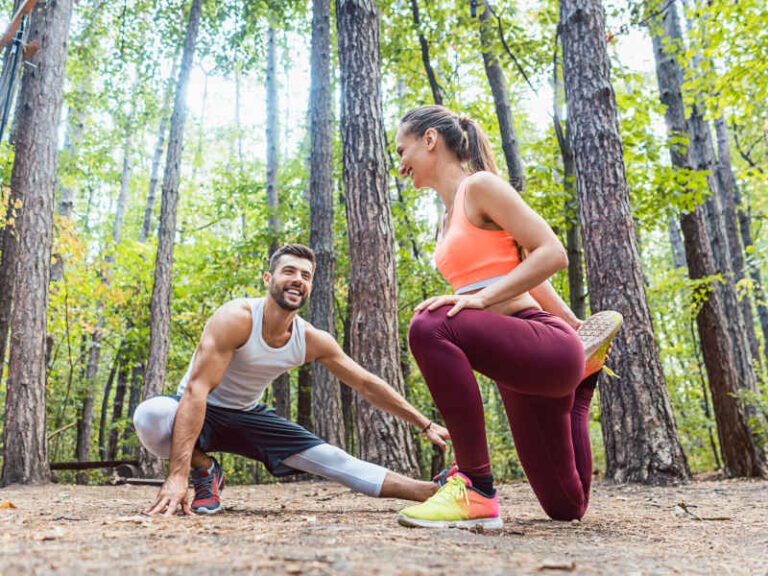
Stress-Busting Secrets: 5 Energizing Workouts for a Happier Mind
In today’s fast-paced world, stress often feels like an unwelcome yet constant companion, casting a shadow over our mental health and well-being.
Like a stubborn knot in our shoulders, stress can weigh us down, leaving us overwhelmed and drained.
But imagine if there were enjoyable, accessible ways to untangle that knot and set ourselves free.
Fortunately, there’s a powerful, natural remedy for stress that’s as revitalizing as a deep breath – exercise.
The transformative connection between exercise and stress reduction is nothing short of magical.
Just as the sun’s warm rays coax a blossoming flower to open, regular physical activity has the power to gently nudge our minds towards a happier, more relaxed state.
Exercise acts as a catalyst for change, helping us replace the burden of stress with a renewed sense of vitality, resilience, and joy.
In this article, we’ll embark on a journey through five energizing workouts that have the potential to turn the tide in your battle against stress.
Picture yourself as a mighty warrior, armed with the tools to vanquish the stress dragon that lurks in the shadows of your life.
These five workouts are your secret weapons, each with its unique power to ignite a spark of happiness and rejuvenate your mind.
Ready to Step Into Your Power?
Unlock the clarity & wisdom that illuminates your path to a conscious, radiant life
Join the Wholebeing Newsletter Today!
By signing up, you agree to receive our well-being emails, special offers, and agree to the Privacy Policy. You can unsubscribe at any time.
The Benefits of Exercise for Stress Reduction
The Role of Endorphins in Stress Relief
Endorphins, often referred to as our body’s natural “feel-good” chemicals, play a crucial role in stress relief.
These powerful neurotransmitters are released during exercise, much like a symphony of tiny fireworks lighting up the sky of our minds.
As they surge through our system, endorphins create a sense of euphoria, often known as the “runner’s high.”
This uplifting sensation is more than just a fleeting moment of joy; it’s our body’s way of rewarding us for engaging in activities that promote well-being.
Endorphins act as natural painkillers, reducing our perception of pain and discomfort.
At the same time, they counterbalance stress hormones such as cortisol and adrenaline, helping to restore a sense of equilibrium and calm in our minds.
By participating in regular physical activity, we invite these feel-good endorphins to wash over us like a gentle stream, gradually dissolving the accumulated tension and stress within our bodies and minds.
The Impact of Exercise on Mental Clarity & Focus
The power of exercise extends beyond stress relief, reaching into the realms of mental clarity and focus.
As we engage in physical activity, our heart rate increases, pumping oxygen-rich blood to our brains.
Like a cool, refreshing breeze sweeping through a dense fog, this surge of oxygen helps to clear away the mental cobwebs that may have accumulated due to stress.
Furthermore, exercise stimulates the growth of new brain cells and the release of various neurotransmitters, including serotonin and dopamine.
These neurotransmitters play a vital role in regulating our mood, attention, and overall cognitive function.
As a result, exercise not only helps to lift our spirits but also sharpens our mental acuity.
Incorporating regular exercise into our routines, we grant ourselves the opportunity to step back from the chaos and noise of daily life.
This mental space allows us to declutter our thoughts, refocus our priorities, and approach challenges with a newfound sense of clarity and determination.
The Importance of Physical Activity for Overall Well-Being
Physical activity plays an integral role in maintaining not only our mental well-being but also our overall health.
By engaging in regular exercise, we nurture the harmonious relationship between our body, mind, and soul – a vital component of holistic well-being.
From a physical standpoint, exercise helps to strengthen our muscles, improve cardiovascular health, enhance flexibility, and maintain a healthy weight.
These benefits translate into increased energy levels, reduced risk of chronic diseases, and a greater ability to perform everyday tasks with ease.
On an emotional level, exercise serves as a powerful tool for self-care, providing an outlet for pent-up emotions and allowing us to reconnect with our inner selves.
As we challenge our physical limits and overcome obstacles, we gain a sense of accomplishment and self-confidence, fostering a positive self-image and increased resilience to life’s stressors.
Lastly, physical activity can also have a profound impact on our spiritual well-being.
Through mindful practices such as yoga or tai chi, we can cultivate a deeper sense of connection to our bodies, our breath, and the present moment.
This heightened awareness and inner harmony can inspire a sense of purpose, tranquility, and gratitude that radiates throughout all aspects of our lives.
Incorporating regular exercise into our lives is an invaluable investment in our overall well-being that empowers us to live a more balanced, joyful, and fulfilling life.

Workout 1: High-Intensity Interval Training (HIIT)
High-Intensity Interval Training (HIIT) is a powerful and time-efficient workout method that can help you bust stress and bolster your mental well-being.
At its core, HIIT involves alternating between short bursts of intense exercise and periods of lower-intensity activity or rest.
These intervals can be customized to fit your fitness level, making HIIT an accessible and adaptable option for people from all walks of life.
From a fitness standpoint, HIIT is known for its ability to increase cardiovascular endurance, build lean muscle, and burn calories more effectively than traditional steady-state cardio workouts.
When it comes to stress relief, HIIT’s intense nature can act as a powerful catalyst for endorphin release.
As you push yourself to the limits during the high-intensity intervals, your body rewards you with a surge of these feel-good chemicals, helping to lift your mood and alleviate stress.
Moreover, the focus required to perform the challenging exercises can serve as a mental distraction from daily stressors, providing a much-needed break for your mind.
Regular HIIT workouts also improve mood regulation by increasing the production of serotonin and dopamine – neurotransmitters responsible for stabilizing mood, enhancing motivation, and promoting feelings of happiness and well-being.
By pushing your physical limits during HIIT, you develop mental toughness and resilience.
As you progress in your HIIT workouts and see improvements in your fitness and strength, you’ll likely experience a boost in self-esteem and self-confidence.
Additionally, participating in group HIIT classes or partnering up with a workout buddy can foster a sense of camaraderie and social support, further enhancing your mood and providing a network of encouragement to help you navigate life’s stressors.
Bust That Stress: Example HIIT Workout Routine
Here is a sample HIIT workout routine that you can try at home or at the gym.
This workout requires no equipment and can be adjusted to fit your fitness level.
Remember to warm up before starting and to cool down and stretch afterward.
Warm-Up (5 minutes):
- Jumping jacks or march in place
- Arm circles
- Leg swings
- High knees
- Butt kicks
HIIT Workout (20 minutes):
Perform each exercise for 40 seconds at high intensity, followed by a 20-second rest.
Complete 4 rounds with a 1-minute rest between each round.
1. Jump Squats: Stand with feet shoulder-width apart, perform a squat, and then explode upward into a jump. Land softly and immediately lower into another squat.
2. Push-ups: In a plank position with hands shoulder-width apart, lower your body to the ground, keeping your elbows close to your body. Push back up to the starting position. Alter the exercise by performing push-ups on your knees or up against a wall.
3. Mountain Climbers: Start in a plank position. Bring one knee toward your chest, then quickly switch legs, as if you’re running in place. Maintain a tight core and ensure your back remains straight throughout the movement.
4. Burpees: Starting in a standing position, lower into a squat and place your hands on the floor. Jump your feet back to assume a plank position, complete a push-up, and then jump your feet forward to return them to your hands. Finish by jumping up with arms overhead. Modify by stepping back into plank position and omitting the push-up.
5. Bicycle Crunches: Position yourself lying down on your back, with your hands placed behind your head and your legs fully stretched out. Bring one knee to your chest while simultaneously twisting your torso to bring the opposite elbow to that knee. Switch sides and continue alternating.
Cool Down & Stretch (5 minutes):
- Deep breaths
- Standing forward fold
- Quad stretch
- Hamstring stretch
- Chest stretch
- Shoulder stretch
This example HIIT workout routine is designed to target your whole body, providing a balanced and efficient workout that can help reduce stress and improve your mood.
Remember to listen to your body and modify exercises as needed to suit your individual needs and abilities.

Workout 2: Yoga
Yoga, an ancient practice weaving together physical postures, breath control, and meditation, serves as a sanctuary for the mind, body, and spirit.
Like a refreshing breeze on a hot summer day, yoga brings a sense of calm and renewal, washing away stress and nurturing overall well-being.
Imagine the feeling of a weight being lifted off your shoulders as you flow through each pose, your body and mind finding harmony and balance.
With each deep breath and deliberate movement, yoga gently leads you into a state of relaxation and mindfulness.
The physical postures, or asanas, release tension held in the muscles, making way for a sense of ease and comfort.
The gentle stretching and strengthening exercises promote self-awareness, self-compassion, and functional strength.
The deep, rhythmic breathing central to yoga practice is like a soothing balm for the mind, calming the constant chatter in your head.
By focusing on your breath and embracing the present moment, you embark on a journey of self-discovery, unearthing self-awareness, self-acceptance, and emotional resilience.
Moreover, the meditative components of yoga foster a deeper connection to your inner self, cultivating a sense of inner peace and tranquility.
This inner calmness radiates outward, influencing your daily interactions and helping you navigate life’s challenges with grace and resilience.
Integrating yoga into your daily or weekly routine, you’re not only investing in your physical and mental health but also nurturing a deep sense of self-care.
Find Your Zen: Yoga Poses for Stress Relief
To help you find that much-needed calm and balance, we’ve compiled a list of five yoga poses that can alleviate stress and promote relaxation.
These poses are suitable for all levels and can be easily integrated into your daily routine.
Child’s Pose (Balasana): A restorative pose that gently stretches the back, hips, and thighs while calming the mind.
Begin by kneeling on your mat, positioning your knees at hip-width distance apart, and allowing your big toes to gently touch each other.
Sit back on your heels, then bend forward, allowing your chest to rest on your thighs and your forehead to touch the mat.
Extend your arms alongside your body with your palms facing down, or reach them forward for a gentle shoulder stretch.
Take slow, deep breaths, and hold the pose for 30 seconds to a few minutes.
Cat-Cow Pose (Marjaryasana-Bitilasana): A gentle flow that relieves tension in the spine and neck while promoting flexibility.
Start in a tabletop position, placing your wrists directly beneath your shoulders and your knees aligned under your hips.
As you take a deep inhale, raise your chest and tailbone towards the sky while letting your abdomen descend towards the ground (Cow Pose).
As you exhale, round your spine, tucking your tailbone and bringing your chin toward your chest (Cat Pose).
Continue flowing between these poses for several breaths, focusing on the movement of your spine.
Legs-Up-The-Wall Pose (Viparita Karani): A restorative inversion that helps to relax the nervous system and reduce stress.
Place a folded blanket or bolster against a wall.
Sit with your right hip against the wall and your knees bent.
Gently lower your back onto the floor as you swing your legs up onto the wall.
Adjust your hips so they are comfortably supported, and extend your arms alongside your body.
Close your eyes and breathe deeply, holding the pose for 5 to 15 minutes.
Seated Forward Bend (Paschimottanasana): A calming pose that stretches the spine, shoulders, and hamstrings.
Position yourself on your mat, extending your legs straight out before you.
Inhale and lengthen your spine, then exhale and fold forward from your hips, reaching for your toes, ankles, or shins.
Allow your head to relax toward your knees.
Hold the pose for 30 seconds to a few minutes, focusing on your breath and releasing tension with each exhale.
Corpse Pose (Savasana): The ultimate relaxation pose that allows the body and mind to fully release and rest.
Lie on your back with your legs extended and slightly apart, and your arms relaxed alongside your body, palms facing up.
Close your eyes and allow your entire body to soften and release any remaining tension.
Breathe deeply and remain in the pose for 5 to 15 minutes, allowing your mind to become calm and still.
Incorporate these yoga poses into your routine as a way to decompress and cultivate tranquility in your life.
As you practice, you’ll discover the power of yoga to soothe your mind, reduce stress, and create a peaceful haven in the midst of life’s challenges.

Workout 3: Dancing
Dancing is not only a captivating and expressive art form but also an enjoyable and effective way to exercise.
It serves as a full-body workout that improves cardiovascular fitness, strength, flexibility, and balance.
The rhythmic movements and lively music associated with dancing stimulate the release of endorphins, the body’s natural “feel-good” hormones, which boost mood and create a sense of joy and freedom.
By engaging the body, mind, and spirit simultaneously, dancing fosters emotional expression, self-awareness, and creativity.
Moving to the rhythm of the music allows individuals to express their feelings through movement, often resulting in a sense of emotional release and inner peace.
The immersive nature of dancing encourages mindfulness and being present in the moment, which helps to quiet the mind and provide relief from daily stressors.
Furthermore, as a social activity, dancing provides opportunities to connect with others, share experiences, and build a sense of community.
Participating in group dance classes or events can lead to the formation of new friendships and the support of a like-minded community, all of which contribute to reducing stress and enhancing overall well-being.
Dance transcends age, culture, and skill level, inviting everyone to experience its transformative power and discover the profound benefits of stress reduction and improved mental wellness.
Grooving Away the Blues: Dance Styles for Stress Relief
Zumba: This high-energy, Latin-inspired dance workout combines aerobic exercise with infectious rhythms, creating a fun and exhilarating experience. Zumba classes are suitable for all fitness levels and are an entertaining way to let off steam and forget about daily worries.
Hip-Hop: With its dynamic and expressive movements, hip-hop dance is an excellent way to release tension and channel your energy into creativity. Hip-hop routines often incorporate both fast and slow movements, allowing you to explore various emotions while improving your strength and flexibility.
Salsa: This passionate Latin dance style is known for its lively music and sensual movements. Salsa promotes connection and communication between dance partners and offers an enjoyable social experience that can help you de-stress and unwind.
Swing: Swing dance, with its upbeat music and playful steps, is sure to put a smile on your face. Whether you prefer the smooth Lindy Hop or the energetic Jitterbug, swing dancing is an engaging way to relieve stress and boost your mood.
Belly Dancing: This ancient dance form is an empowering and graceful way to reduce stress and express your femininity. Belly dancing focuses on fluid, flowing movements that engage your core and improve posture while offering a calming and meditative experience.
Freestyle Dancing: Don’t feel confined to a specific dance style – simply turn on your favorite tunes and let your body move freely. Freestyle dancing is a liberating way to release tension, express yourself, and connect with your emotions, all while having fun and getting a great workout.

Workout 4: Boxing
Boxing is a powerful and intense form of exercise that offers a myriad of physical and mental benefits.
As a full-body workout, boxing engages various muscle groups, including the core, legs, and upper body, helping to build strength, endurance, speed, and coordination.
From a mental standpoint, boxing serves as an excellent stress-reliever.
The act of striking targets or a heavy bag demands focus, discipline, and concentration, allowing you to channel your energy into each punch.
The intense physical exertion of boxing helps to release endorphins, which are natural mood-boosters that counteract stress, reduce anxiety and physical pain, while promoting overall well-being.
By honing your mental focus through boxing, you can also develop a greater sense of mental resilience, which can be beneficial in managing stress outside of the gym.
The act of striking and hitting targets in a controlled and safe environment allows for a healthy outlet to release pent-up frustration and tension, leading to a sense of emotional release and relief, helping to alleviate stress and create a more balanced state of mind.
Moreover, boxing can boost self-esteem and self-confidence, as it teaches valuable self-defense skills and empowers individuals to feel stronger and more capable in their daily lives.
Knockout Stress: Example Boxing Routine
The following boxing routine is designed to help you release tension and reduce stress while improving your boxing skills and overall fitness.
Remember to warm up for at least 5-10 minutes before starting the routine and always wear proper boxing gloves to protect your hands and wrists.
Jump Rope (3 minutes): Begin your workout with jump rope to get your heart rate up and improve your footwork. This will help increase agility and coordination while also serving as a dynamic warm-up.
Shadowboxing (3 rounds of 3 minutes each, with 1-minute rest in between): Practice your boxing technique by throwing combinations of punches at an imaginary opponent. Focus on your footwork, head movement, and maintaining proper form. Shadowboxing helps you develop fluidity, speed, and precision in your movements.
Heavy Bag Workout (3 rounds of 3 minutes each, with 1-minute rest in between): Unleash your power on the heavy bag, working on different punch combinations and movement patterns. Hit the bag with intensity, focusing on speed, power, and accuracy. This is an excellent way to release pent-up energy and frustration.
Focus Mitts (3 rounds of 3 minutes each, with 1-minute rest in between): Partner up with someone holding focus mitts or pads and practice your punches and combinations. This exercise helps improve your accuracy, timing, and reaction time while fostering a sense of connection and teamwork.
Cooldown & Stretching (5-10 minutes): End your workout with a cooldown period, incorporating deep breathing exercises and gentle stretches to relax your muscles and bring your heart rate back to its resting state. This will help promote a sense of calm and relaxation after your intense boxing session.
Remember to stay hydrated and listen to your body, as you become more comfortable with boxing, you can increase the intensity and duration of your routine.

Workout 5: Outdoor Nature Walks
Imagine the sun peeking through the leaves of a lush forest, the sound of birdsong filling the air, and the feel of soft earth beneath your feet.
Outdoor nature walks provide a gentle yet effective form of exercise that nourishes both your body and your soul.
Walking in nature encourages mindfulness and presence, helping you to become more aware of the sights, sounds, and smells around you.
Nature has a remarkable ability to soothe frayed nerves and calm the mind.
Research shows that exposure to natural environments can lower cortisol levels, the hormone associated with stress.
Walking outdoors can also increase the production of endorphins, the body’s natural feel-good hormones, leading to a more positive and uplifted mood.
Nature walks can improve cognitive function by stimulating the brain and enhancing focus, memory, and creativity.
Imagine your mind as a clear blue sky, free of clouds, and open to endless possibilities.
Spending time in nature provides a sense of spiritual connection, fostering feelings of peace, harmony, and oneness with the world around you.
This connection can help you gain a deeper understanding of your inner self and the world, promoting a sense of purpose and meaning in life.
These walks also offer a perfect opportunity for social connection, providing a serene space to share experiences with friends and family or meet new people.
A Breath of Fresh Air: Tips for Integrating Nature Walks
Schedule Regular Walks: Treat your nature walks like any other appointment or commitment, and schedule them into your calendar. Aim for consistency, whether that means daily, several times a week, or once a week, depending on your availability and preferences.
Explore Local Parks & Nature Reserves: Discover the green spaces in your local area, such as parks, nature reserves, or nearby trails. You may be surprised by the number of beautiful spots within a short distance from your home.
Choose the Right Time: Find a time of day that works best for you, considering factors like your energy levels, work schedule, and personal preferences. Some people may prefer a calming morning walk to start their day, while others might enjoy an evening stroll to unwind after work.
Invite a Friend or Family Member: Make your nature walks a social event by inviting friends or family members to join you. Sharing the experience can create a sense of connection and support, and it can make the walk more enjoyable and motivating.
Vary Your Walking Routes: To keep things interesting and prevent boredom, explore different walking routes and destinations. This variety will also allow you to experience the diverse beauty of nature and its changing landscapes.
Set Goals: Set achievable goals for your nature walks, such as increasing the distance, duration, or frequency of your walks over time. These goals can help keep you motivated and provide a sense of accomplishment as you progress.
Listen to Your Body: Pay attention to your body’s signals and adjust the intensity and duration of your walks accordingly. It’s important to find a balance between challenging yourself and allowing your body to recover and enjoy the benefits of the activity.
Enhance Your Experience: Deepen your connection with nature by combining your walks with enriching activities. Consider bringing a journal to record your thoughts and observations, practicing photography to capture the beauty around you, or engaging in mindfulness exercises like birdwatching and meditation.
Be Prepared: Dress appropriately for the weather and wear comfortable, supportive shoes. Bring water to stay hydrated, and apply sunscreen, insect repellent, or other necessary precautions as needed.

I hope my content sparks something deeper within: a moment of clarity, a gentle shift, or a deeply felt truth. Creating meaningful content takes time and heart. If you found value here, consider supporting my work to keep this space alive.
Vlad
Conclusion
Movement is a powerful antidote to stress, offering both immediate relief and long-term resilience.
Whether you prefer high-energy workouts or gentle movement, the key is finding activities that resonate with your personal style and needs.
Remember, exercise isn’t just about physical fitness – it’s a vital tool for mental well-being and stress management.
Making movement a regular part of your self-care routine is an investment in both your body and mind.
Start where you are, with what feels right for you, and let physical activity become your natural ally in creating a more balanced, energized life.
Share the Love, Spread the Wisdom
You May Also Like:



